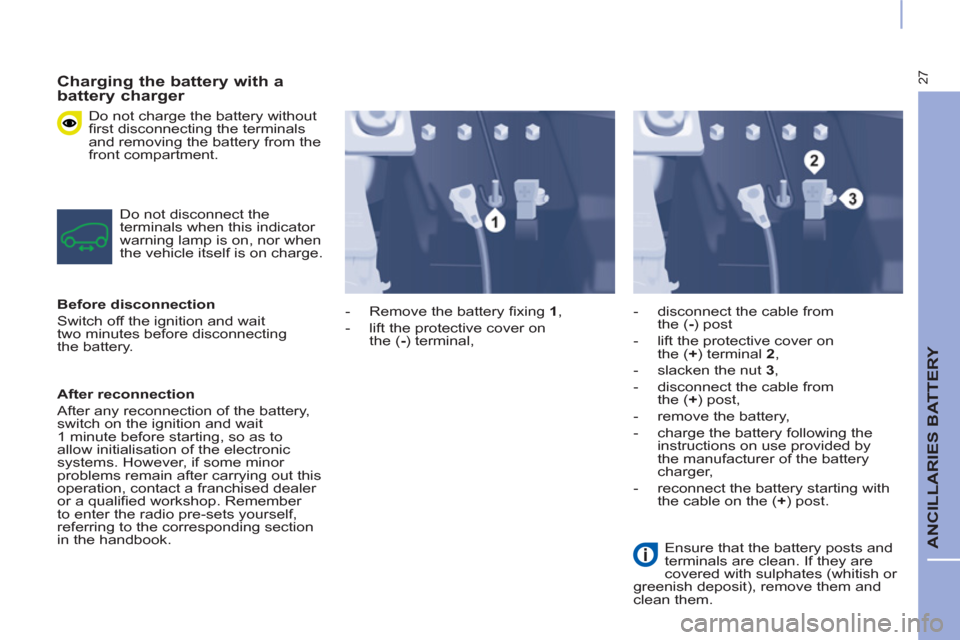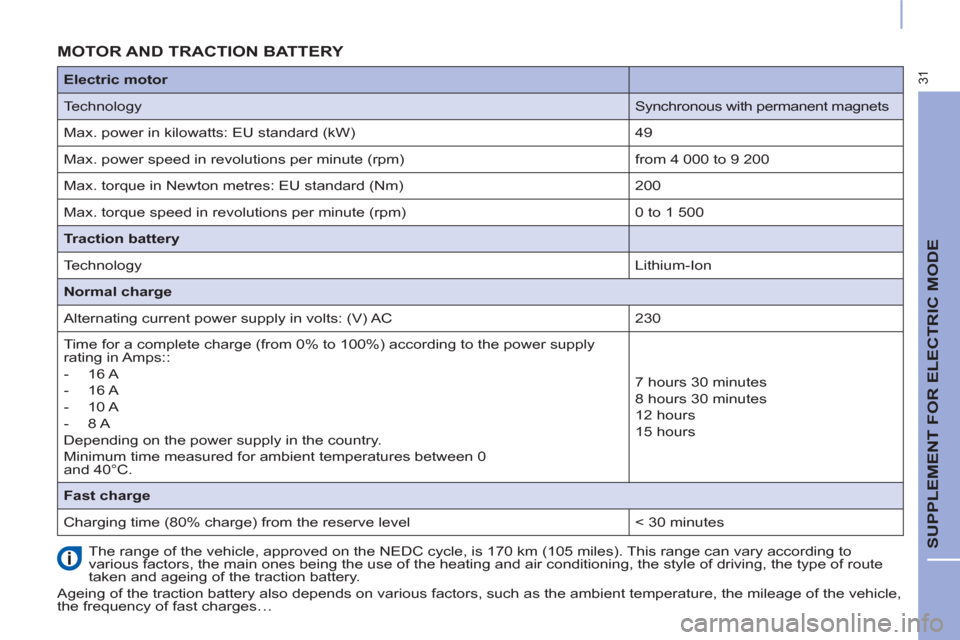Page 283 of 292
25
ANCILLARIES BATTERY
ANCILLARIES BATTERY
All of the other electrical components
on your vehicle are powered by the
ancillaries battery.
It is located in the front compartment
under the bonnet and is charged by
the traction battery, during phases
of operation ("Ready" lamp in in the
instrument panel) and charging.
If the ancillaries battery is
discharged, the electric motor
cannot be started and charging
of the traction battery is no longer
possible.
It is recommended that the
ancillaries battery be disconnected
if the vehicle is not to be used for
more than a month. Before doing anything:
- put the vehicle in position P
,
switch off the ignition, check that
the central display screen is off,
and ensure that the vehicle is not
connected to a power point,
- open the bonnet using the interior
release lever and then the exterior
safety catch,
- secure the bonnet stay,
- remove the protective cover from
the battery for access to the two
terminals.
Access to the battery
Page 285 of 292

27
ANCILLARIES BATTERY
Charging the battery with a
battery charger
Do not charge the battery without
fi rst disconnecting the terminals
and removing the battery from the
front compartment.
Do not disconnect the
terminals when this indicator
warning lamp is on, nor when
the vehicle itself is on charge.
Before disconnection
Switch off the ignition and wait
two minutes before disconnecting
the battery.
After reconnection
After any reconnection of the battery,
switch on the ignition and wait
1 minute before starting, so as to
allow initialisation of the electronic
systems. However, if some minor
problems remain after carrying out this
operation, contact a franchised dealer
or a qualifi ed workshop. Remember
to enter the radio pre-sets yourself,
referring to the corresponding section
in the handbook.
- Remove the battery fi xing 1
,
- lift the protective cover on
the ( -
) terminal,
- disconnect the cable from
the ( -
) post
- lift the protective cover on
the ( +
) terminal 2
,
- slacken the nut 3
,
- disconnect the cable from
the ( +
) post,
- remove the battery,
- charge the battery following the
instructions on use provided by
the manufacturer of the battery
charger,
- reconnect the battery starting with
the cable on the ( +
) post.
Ensure that the battery posts and
terminals are clean. If they are
covered with sulphates (whitish or
greenish deposit), remove them and
clean them.
Page 289 of 292

31
SUPPLEMENT FOR ELECTRIC MODE
MOTOR AND TRACTION BATTERY
The range of the vehicle, approved on the NEDC cycle, is 170 km (105 miles). This range can vary according to
various factors, the main ones being the use of the heating and air conditioning, the style of driving, the type of route
taken and ageing of the traction battery.
Ageing of the traction battery also depends on various factors, such as the ambient temperature, the mileage of the vehicle,
the frequency of fast charges…
Electric motor
Technology
Synchronous with permanent magnets
Max. power in kilowatts: EU standard (kW)
49
Max. power speed in revolutions per minute (rpm)
from 4 000 to 9 200
Max. torque in Newton metres: EU standard (Nm)
200
Max. torque speed in revolutions per minute (rpm)
0 to 1 500
Traction battery
Technology
Lithium-Ion
Normal charge
Alternating current power supply in volts: (V) AC
230
Time for a complete charge (from 0% to 100%) according to the power supply
rating in Amps::
- 16 A
- 16 A
- 10 A
- 8 A
Depending on the power supply in the country.
Minimum time measured for ambient temperatures between 0
and 40°C.
7 hours 30 minutes
8 hours 30 minutes
12 hours
15 hours
Fast charge
Charging time (80% charge) from the reserve level
< 30 minutes